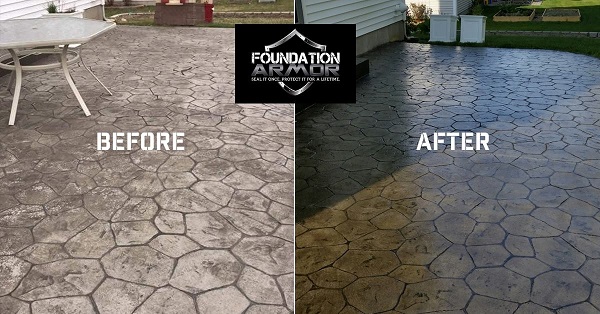The photo featured above was take from Foundation Armor. It features a before and after photo of their Armor AR350 Wet Look Sealer on a stamped concrete patio.
The best way to achieve a wet look is with an acrylic concrete sealer. The resins in acrylic sealers will darken the color of the concrete to give it a similar appearance to being wet. Not all types of acrylic sealers can provide a wet look however. Water based acrylic sealers can give concrete a gloss appearance, but they won’t darken the surface of the concrete. Only solvent based acrylic sealers can darken concrete enough to make it look wet.
Wet Look Sealer Reviews:
- Armor AR350 Wet Look Sealer Review
- Eagle High Gloss Sealer Review
- Enduraseal SB Acrylic Sealer Review
When it comes to choosing a wet look concrete sealer, there are a few things you want to consider. While wet look sealers will provide a similiar look, they vary greatly in life and performance.
- Where is the wet look sealer manufactured? Acrylic sealers are either made from non-recycled U.S. manufactured resins, or imported recycled resins. The problem with recycled resins is that they contain additional chemicals. Many of the chemicals used to recycle the resins can’t be removed and are left in the sealer. Additives are put into the acrylic to counter the chemicals, but in many cases the mixture of additives and chemicals cause the acrylic to break down faster. This is why when you purchase a $100 pail of acrylic sealer from a hardware store you find yourself re-coating every 6 months to a year. Products made from non recycled U.S. manufactured resins come at a higher price tag (around $200/pail), you are getting a pure acrylic sealer. You will find these products perform better and last 1-2 years longer on average.
- What is the percent of solids? The ideal level of solids for an acrylic sealer is 20-25%. Higher solids solutions are less breathable and tend to fail faster outdoors, and lower solids solutions tend to wear down faster. You want to look for a 20-25% solids solution.
- What type of acrylic sealer is it? There are three types of acrylic sealers: acrylic lacquer sealers, acrylic co-polymers, and acrylic latex sealers. Acrylic latex sealers are pretty much paint and should be avoided at all costs. They may be cheap and easy to apply, but they don’t want and will provide quite the headache when it comes time to recoat. Acryilc lacquer sealers are pure acrylic sealers. They are great for already cured concrete, and pavers. Acrylic co-polymer sealers contain styrene and are used as cure and seals for new concrete.
Wet Look Concrete Sealers
There are many benefits to using a wet look sealer:
- Wet look concrete sealers will darken the entire surface of the concrete to provide a consistent color.
- Wet look concrete sealers will help to bring back dull or faded concrete.
- Wet look concrete sealers will protect the surface against mold, mildew, and efflorescence.
- Wet look concrete sealers will reduce deterioration caused by water absorption.
- Wet look concrete sealers will reduce damage caused by freeze-thaw cycles and salt.
- Wet look concrete sealers will reduce staining caused by hot tire pickup and oil spills.
It is very easy to apply a wet look sealer to concrete. First, make sure the concrete is clean and dry. If a pressure washer was used, or if the surface was wet down with water, allow the concrete 24 hours to completely dry. Using a roller or sprayer, apply your first coat of wet look sealer. Allow the first coat to dry for 24 hours and then recoat. This will help to achieve a higher level of gloss. Let dry. Always check with the manufacturer and follow their instructions because certain formulations may require specific application instructions.
It is best to apply a wet look sealer in the late afternoon or early evening, after the concrete has had a chance to cool down from exposure to the sun. Do not apply a wet look sealer in the morning when dew is present on the concrete, and do not apply a wet look sealer if it is expected to rain 24 hours after applying. Acrylics are sensitive to moisture and should be applied when the concrete is dry and rain isn’t in the forecast.

